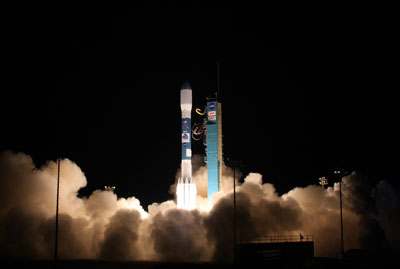|
|

|
 |
| Forum: | Satellites - Robotic Probes |
| Topic: | NASA's NPOESS Preparatory Project satellite |
|
| Want to register?
|
If you have previously registered, but forgotten your password, click here.
The Delta II launch vehicle that delivered NPP into orbit also deployed auxiliary payloads within 98 minutes after launch. The five small "CubeSat" research payloads are the third in a series of NASA Educational Launch of Nanosatellite missions, known as ELaNa missions. The NPP mission is managed by NASA's Goddard Space Flight Center in Greenbelt, Md., for the Earth Science Division of the Science Mission Directorate at NASA Headquarters in Washington. The Joint Polar Satellite System program provides the NPP ground system. NOAA will provide operational support for the mission. Launch management is the responsibility of the NASA Launch Services Program at the Kennedy Space Center in Florida. | | Robert Pearlman | United Launch Alliance release United Launch Alliance Delivers 50th Delta II Mission to Orbit for NASA with the Successful Launch of the NPOESS Preparatory ProjectA United Launch Alliance Delta II rocket carrying the NPOESS Preparatory Project (NPP) spacecraft for NASA lifted off from Space Launch Complex-2W here at 2:48 a.m. PDT today. This is ULA's 10th launch of the year and marked the 55th successful launch for the company. 
Credit: ULA/William G. Hartenstein"ULA is proud to have served NASA with 50 Delta II launches, achieving 100 percent mission success for a very diverse array of exceptionally important science missions," said Jim Sponnick, ULA vice president, Mission Operations. "Today's successful NPP launch is a critical first step in demonstrating our country's next-generation earth-observing satellite system. NPP will monitor weather conditions and gather climate data to greatly improve our knowledge of Earth's systems." This mission was launched aboard a Delta II 7920-10 configuration vehicle featuring a ULA first stage booster powered by a Pratt & Whitney Rocketdyne RS-27A main engine and nine Alliant Techsystems (ATK) strap-on solid rocket motors. An Aerojet AJ10-118K engine powered the second stage. The payload was encased by a 10-foot-diameter composite payload fairing. "In addition to the NPP spacecraft, the Delta II also carried three Poly Picosatellite Orbital Deployers (P-POD) dispensers on the upper stage that deployed six cubesats following completion of the primary NPP mission," said Sponnick. "We are pleased that ULA can provide access to space for these university research satellites and expand the reach of the science community." NPP will extend and improve upon the Earth climate data records established by NASA's Earth Observing System (EOS) fleet of satellites that have provided critical insights into the dynamics of the entire Earth system: clouds, oceans, vegetation, ice, solid Earth and atmosphere. 
Credit: ULA/William G. Hartenstein"The Delta II vehicle continues to offer excellent reliability and best value to our customers," said Sponnick. "We look forward to working with our customers to provide future Delta II launches here at Vandenberg." ULA program management, engineering, test, and mission support functions are headquartered in Denver, Colo. Manufacturing, assembly and integration operations are located at Decatur, Ala., and Harlingen, Texas. Launch operations are located at Cape Canaveral AFS, Fla., and Vandenberg AFB, Calif. | |



